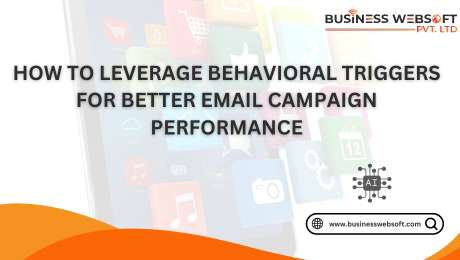In a digital landscape overflowing with content material, personalization is now not a luxury—it’s a need. Email advertising stays one of the only ways to reach your target market; however, the actual power lies in behavioral triggers — automated movements based totally on how users interact with your emblem. This statistics-pushed approach enables entrepreneurs to deliver well-timed, relevant emails that connect, convert, and hold clients.
we’ll dive into what behavioral trigger emails are, why they’re effective, and the way to put them into effect to dramatically improve your email advertising overall performance.
What Are Behavioral Trigger Emails?
Behavioral triggers are automatic emails that are dispatched in response to precise actions (or inactions) taken by means of a user. Instead of sending one-size-suits-all messages, you could tailor your conversation based on how customers interact along with your website, emails, or merchandise.
- Common Trigger Actions Include:
- Signing up for an e-newsletter
- Abandoning a cart
- Browsing particular product pages
- Making a purchase
- Inactivity for a certain period
- Clicking a specific link in an e-mail
By looking at these behaviors, you can automate compliance follow-up emails that seem quite personalized— increasing open prices, engagement, and conversions.
Why Behavioral Emails Work
Let’s look at why behavioral emails outperform traditional campaigns:
✅ Timely—Triggered emails are sent right when users take an action, making the content more relevant.
✅ Personalized—These emails are based on actual behavior, not assumptions, creating a better user experience.
✅ High Engagement Rates—Studies show that behavioral emails have up to 152% higher click-through rates compared to standard newsletters.
✅ Improved Conversion—Sending emails based on customer intent drives better results, especially in e-commerce and SaaS industries.
Top Behavioral Email Triggers to Use in Your Campaigns
Let’s discover the simplest behavioral triggers you could use right now:
1. Welcome Emails
Trigger: User signs up or creates an account.
These are your first risks to make an influence. Use welcome emails to:
Introduce your logo.
Provide useful resources.
Offer a special bargain.
Tip: Add personalization and make the email conversational and warm.
2. Abandoned Cart Emails
Trigger: User adds objects to cart but doesn’t hold the acquisition.
These are gold for recuperating lost income. A well-timed reminder with product photographs, shortage messaging, and perhaps a small cut price can deliver customers back.
3. Product Browsing Emails
Trigger: User views a product/category page but takes no action.
Remind users of the items they explored. This diffused nudge often reignites purchase rationale.
Example Subject Line: “Still considering those shoes? 👟
4. Post-Purchase Follow-up
Trigger: After a hit purchase
These emails can include:
- Order confirmation
- Shipping updates
- Review request
- Product care pointers or upsell hints
Tip: Show appreciation and fortify brand acceptance.
5. Re-Engagement Emails
Trigger: User has been inactive for a set period.
Win back lapsed subscribers by reminding them of what they’re lacking. Use personalization and exceptional gifts to spark interest.
Example: “We miss you — here’s 15% off to come back returned!”
6. Milestone or Anniversary Emails
Trigger: Account anniversary, birthday, or milestone done
These Marvel messages create emotional connections and loyalty.
Example: “Happy 1-Year Anniversary! Thanks for being with us — right here’s a present.”
How to Set Up Behavioral Trigger Emails
Here’s a step-by-step manual to getting started out:
Step 1: Choose the Right Email Marketing Tool
Use systems that aid automation and segmentation, which include:
- Klaviyo
- Mailchimp
- ActiveCampaign
- HubSpot
Step 2: Identify Key Behaviors
Look at your patron adventure and spotlight important movements well worth triggering an email.
Step 3: Segment Your Audience
Break your listing into segments like new customers, repeat shoppers, or lapsed clients for targeted messaging.
Step 4: Craft Engaging Content
Use dynamic content blocks, customize the problem line, and include clean CTAs (calls to motion).
Step 5: Test and Optimize
A/B test issue strains, electronic mail replica, pix, and timing to enhance overall performance over time.
Best Practices for Behavioral Trigger Emails
🔹 Personalization is Key—Use first names, product names, and relevant context to create deeper connections.
🔹 Timing Matters—Send emails at the right moment to catch users when they’re most likely to act.
🔹 Keep It Simple—One clear message per email helps avoid overwhelming the user.
🔹 Use Visuals—Product images, GIFs, and personalized visuals increase engagement.
🔹 Respect Frequency—Don’t bombard users with too many emails — find a balance.
Real-World Examples of Brands Using Behavioral Triggers
- Amazon—Sends abandoned cart reminders and browsing follow-ups with curated suggestions.
- Spotify—Uses listening behavior to suggest playlists and celebrate user milestones.
- Airbnb—Sends re-engagement emails if users haven’t booked in a while, often with travel inspiration.
Conclusion
Behavioral cause emails are one of the most effective pieces of equipment in your email marketing approach. They will let you connect to your audience at exactly the right moment with applicable, personalized content.
By leveraging patron facts and automating your emails based totally on behavior, you may drive more sales, construct loyalty, and improve the general client experience.
Ready to take your email marketing to the next level? Start building behavioral trigger campaigns today!
